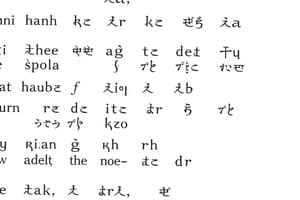Podcast
Questions and Answers
What is a language family?
What is a language family?
- A group of languages that share the same grammar rules.
- A group of languages that are spoken in the same geographic area.
- A group of languages that have the same writing system.
- A group of languages that are related through a common ancestral language or proto-language. (correct)
Which two language families have the most speakers?
Which two language families have the most speakers?
- Sino-Tibetan and Afro-Asiatic
- Indo-European and Niger-Congo
- Austronesian and Austroasiatic
- Indo-European and Sino-Tibetan (correct)
How many independent language families are there, including language isolates?
How many independent language families are there, including language isolates?
- 1,000
- 142
- 7,151
- 406 (correct)
What is a proto-language?
What is a proto-language?
What are language isolates?
What are language isolates?
What is a sprachbund?
What is a sprachbund?
What can language contact lead to?
What can language contact lead to?
What is the linguistic tree?
What is the linguistic tree?
What is the relationship between the linguistic tree and the genetic tree of human ancestry?
What is the relationship between the linguistic tree and the genetic tree of human ancestry?
Flashcards
Language Family
Language Family
A group of languages related through a shared ancestor (proto-language).
Proto-language
Proto-language
The hypothetical ancestor of languages within a family.
Language Isolates
Language Isolates
Languages with no known relatives, their origins are a mystery.
Sprachbund
Sprachbund
Signup and view all the flashcards
Indo-European and Sino-Tibetan
Indo-European and Sino-Tibetan
Signup and view all the flashcards
Linguistic Tree
Linguistic Tree
Signup and view all the flashcards
Linguistic Tree and Human Ancestry
Linguistic Tree and Human Ancestry
Signup and view all the flashcards
Language Contact
Language Contact
Signup and view all the flashcards
Pidgin
Pidgin
Signup and view all the flashcards
Study Notes
Overview of Language Families
- A language family is a group of languages that are related through a common ancestral language or proto-language.
- There are approximately 7,151 living languages in the world, distributed among 142 different language families.
- The Indo-European and Sino-Tibetan language families have the most speakers.
- Linguists identify 406 independent language families, including language isolates.
- Membership in a language family is established by research in comparative linguistics.
- Language families can be divided into smaller phylogenetic units, known as branches of the family.
- Language isolates are languages that have no known relatives or for which family relationships are only tentatively proposed.
- A proto-language is the root from which all languages in a family stem from.
- A sprachbund is a geographic area having several languages that feature common linguistic structures.
- Language contact can lead to the development of new languages from the mixture of two or more languages, such as pidgins.
- Language contact can also lead to cultural divisions and territorialism.
- The linguistic tree and the genetic tree of human ancestry show a remarkably similar pattern, verified statistically.
Studying That Suits You
Use AI to generate personalized quizzes and flashcards to suit your learning preferences.




